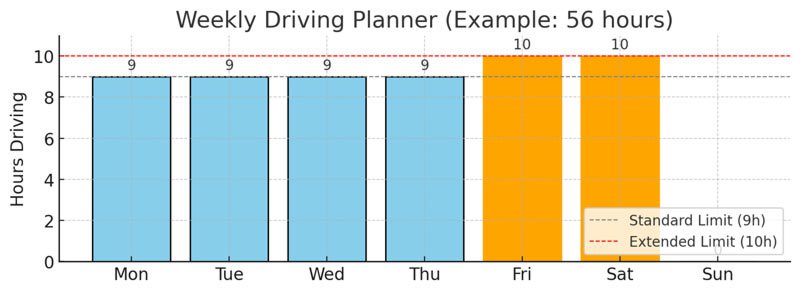HGV drivers’ hours explained: what operators really need to know
Getting drivers’ hours wrong doesn’t just risk fines. For waste operators and fleet managers it can derail daily schedules, cut into margins, and put contracts at risk — not to mention the obvious safety concerns when tired drivers are on the road.
That’s why the rules around HGV driving hours are so strict. UK and EU law limits how long drivers can work each day and week, and it sets out when breaks must be taken. These rules apply to anyone driving a vehicle over 3.5 tonnes in Great Britain for trade or business purposes, including waste and recycling fleets.
In this guide we’ll cover:
- The legal limits on daily, weekly and fortnightly driving hours.
- How rest breaks fit into typical waste and skip hire schedules.
- A practical example of route planning within the rules.
- Free tools and resources to help you stay compliant.
Let’s start with the basics — the rules themselves
What are the legal HGV driver hours in the UK?
Drivers’ hours are UK government rules controlling the length of time an HGV can be driven daily, weekly and fortnightly. They also govern how often drivers must take rest breaks. These limits exist to reduce accidents caused by fatigue.
Time spent driving
In practice, most HGV shifts are limited to a maximum of 9 hours of driving in a day. This driving time usually forms part of a longer working shift of around 11 hours in total. Within that daily limit, drivers must take a 45-minute break after no more than 4.5 hours behind the wheel. This break can be taken in one block or split into shorter periods (e.g. 15 minutes + 30 minutes), but it must interrupt driving and count as rest.
In practice, this often means a skip collection round must be planned to return drivers to a depot or transfer station in time for their break, otherwise the day quickly overruns
Maximum daily driving hours
An HGV driver can drive for up to 9 hours per day.
This limit can be extended to 10 hours on two days within the same week.

These rules apply in England, Scotland and Wales. Different legislation applies in Northern Ireland. For night shifts, the limit is generally 10 hours of work per shift, though this can be increased under a workforce agreement. For example, a tipper driver starting at 6am may legally extend their shift to 10 hours on two days a week to cover late-running demolition jobs, but fleet managers need to schedule the following days carefully to avoid knock-on delays.
To make this easier to understand in practice, the chart below shows a typical daily schedule. A standard day allows up to 9 hours of driving, split by a mandatory 45-minute break after 4.5 hours. On two days per week this limit can be extended to 10 hours, as shown in orange.

How many hours can be driven in a fortnight?

Over any two consecutive weeks, an HGV driver must not exceed 90 hours of driving.
- A “week” runs from 00:00 Monday to 24:00 Sunday.
- Example: If a driver completes 56 hours in week 1 (e.g. four 9-hour days plus two 10-hour days), they can only drive a maximum of 34 hours in week 2 to stay within the 90-hour limit.
The pattern then resets for the following fortnight (see chart).
Waste hauliers often see busy weeks followed by quieter ones. For instance, after a full 56-hour week handling a large construction clearance, drivers may only be scheduled for 34 hours the next week to stay within the legal 90-hour limit.
What is the maximum permitted average weekly working time hours?

While an HGV driver can drive up to 56 hours in a single week, the rules are designed to ensure that the average is lower when measured across a longer period.
- Over any two consecutive weeks, total driving time must not exceed 90 hours.
- This means if one week reaches the maximum of 56 hours, the following week can only total 34 hours.
- The same balance continues over longer periods, ensuring drivers don’t average more than 45 hours per week across each fortnight.
The chart above shows how this plays out across four consecutive weeks.
Driver hours and rest breaks
Rest breaks are designed to prevent fatigue and must be scheduled according to both driving time and overall working time.
Breaks from driving
- A driver must take a 45-minute break after no more than 4.5 hours of driving.
- This break can be:
- Taken in full (one block of 45 minutes), or
- Split into shorter breaks (at least 15 minutes + 30 minutes).
- Breaks must interrupt work — drivers cannot carry out other duties during this time.
- Breaks shorter than 15 minutes don’t count, but also don’t add to driving time.
Breaks from working time
- If total working time is up to 6 hours → no break required.
- If working time is 6–9 hours → at least a 30-minute break.
- If working time is over 9 hours → at least a 45-minute break.
(Note: if this work includes driving, the driver-hours rule of a 45-minute break after 4.5 hours will usually take precedence.)
Example
A driver spends 3 hours driving, takes a full 45-minute break, then continues driving for another 4.5 hours. This schedule complies with both driving and working time regulations.
If a driver is booked on a round with multiple long-distance skip runs, the 45-minute break needs to be built into the route plan — ideally at a transfer station or site with welfare facilities — not left to chance on the roadside.
Planning tip: When scheduling waste collections, align driving limits with transfer station opening hours — otherwise drivers may hit their legal break just as the site closes.
What is an HGV Split Break?
A 45-minute break can be split in to two parts as long as they’re both taken over the same driving period. This is known as a split break.
HGV split breaks enable a driver to take their rest periods at convenient points in a journey.
The first break must be a minimum of 15 minutes and the second break must be a minimum of 30 minutes long to ensure that the driver is getting the full 45 minutes rest for every 4.5 hours of driving.
The first break period must be a minimum of 15 minutes and the second break must be no shorter than 30 minutes during one 4.5h driving period.
If split breaks don’t add up to 45 minutes a driver is committing a criminal offence, which could result in both the driver and operator being charged.
HGV driver hours – daily rest periods
The working time directive for HGV driver hours states that drivers should have a regular daily rest period of 11 hours. This can be broken down in to two periods: Period 1 – a minimum of three hours; and Period 2 – a minimum of nine hours, bringing the total to 12 hours rest.
Rest is classified as an uninterrupted period where you are able to freely dispose of your time.
Within 24 hours of starting a shift you must complete a daily rest period which, as stated above, is normally 11 hours long.
The 11-hour rest period can be reduced to 9 hours but only three times a week. This will be classed as a reduced daily rest period. But beware, any rest over 9 hours and under 11 hours will still be classed as a reduced daily rest period, even if you didn’t reduce it all the way to 9 hours.
Any shift that is longer than 13 hours will mean a driver needs to use a reduced daily rest period from their quota of three reduced daily rests per week. The maximum shift length that can be worked is 15 hours, leaving 9 hours for a reduced daily rest.
Over a week, drivers must have 45 hours rest. This can be reduced to 24 hours provided that the working fortnight also includes one full rest of 45 hours.
An example of rest breaks is set out below:
A driver begins work at 7:00am on day 1. By 7am on day 2 they must have completed one of the following:
- A regular daily rest period of 11 hours, uninterrupted
- A split regular daily rest period of 12 hours, taken in two separate periods, the first being a minimum of 3 hours, the second at least 9 hours
- A reduced daily rest period (if quota not already used) of a minimum of 9 hours uninterrupted (but not over 11 hours)
What is a split daily rest?
Periods of rest from HGV-related work are required by law. HGV drivers must have a minimum 11- hour daily rest, which can be reduced to 9 hours up to three times a week.
If the daily rest is 12 hours long, it can be split in to two periods, the first being a minimum of 3 hours long and the second being a minimum of 9 hours. This is known as a split daily rest and is illustrated below. A split daily rest must be completed within 24 hours of a shift being started.

What do I need to know about weekly rests?

Weekly rests must have no more than 6 days between them. A minimum of two weekly rests must be taken in any two consecutive weeks. One of those rests must be at least 45 hours long (e.g. one 45-hour rest every other week).
Some working patterns allow for two consecutive reduced weekly rests:
The two-week period that includes weeks 2 and 3 in the table above contains three weekly rests. The weekly rest that starts in one week and finishes in another can be counted in either week but not in both. If the 45-hour rest is counted in week 3 then the weekly rest rules are met.

Any reduction in rest must be compensated by an equal amount of rest being added in one block by the end of the third following week, as illustrated in the next table. The added rest must only be added to a rest that is already at least 9 hours long.
I drive with a colleague – how long can I work for?
If more than one driver is on board a vehicle for all driving periods there are special rules regarding daily rest. Essentially, a driver must take at least 9 hours daily rest within 30 hours of the start of a shift and a maximum shift is 21 hours.
You can start a joint driving period with just one driver for the first hour so that the second driver can be picked up en route.
You may also interrupt your daily rest if you are accompanying an HGV on a ferry or train as long as you take regular daily rests of 11 hours and the interruptions total no more than one hour and you have access to a bunk during the rest period.
In summary:
- Rest periods are normally 11 hours a day. This can be reduced to 9 hours but only three times a week
- A minimum of 45 hours rest must be taken each week. This can be reduced to 24 hours by agreement with employer
- You must take two weekly rests within a fortnight. One must be at least 45 hours long
- Rests may be taken in the vehicle provided the vehicle is stationary and is fitted with suitable sleeping facilities.
What’s the difference between driving time and working time?
During a driver’s shift there will be time spent carrying out duties that don’t involve driving. This is classed as working time. Driving time in its purest sense is classed as time spent behind the wheel.
Working time is any time when a driver works for a company/is on duty. If you’re self-employed, working time is only the time spent driving the vehicle or doing other work related to the vehicle or its load.
Driving time is a form of working time and hours aren’t always defined in the same way. It is a complex area to understand. Comprehensive guidance is available from the DVSA.
Working time includes (but isn’t limited to):
- Loading and unloading
- Monitoring of loading and unloading activities
- Driver CPC or other industry specific training
- Vehicle cleaning and vehicle maintenance
- Daily defect walk-round check and report
- Administrative work
- Time spent waiting (also known as advance unknown duration)
- Anything connected with transport operation
Whether a driver is driving their HGV or carrying out other work-related duties the correct breaks must be taken to ensure that their driving and working time rules are met.
Breaks must be distributed within a working shift (i.e. not taken at the start or end of a shift). Furthermore, break periods can double up to act as a break from work and a break from driving if both sets of rules are satisfied.
Weekly work limits
Drivers may work up to a maximum of 60 hours in any week with a 48-hour average over a reference period. Your reference period is calculated by your employer, usually over 17-26 weeks by agreement.
Your employer is responsible for keeping records for this average. You must tell your employer if you carry out any other work for another employer as this needs to be considered in your calculation.
By now you’ll see (if you didn’t already know!) that drivers’ hours, working hours and the WTD are pretty complicated. All working time must be recorded on a weekly record sheet or on a tachograph.
What is a tachograph?
Tachographs are used to record information about driving time, speed and distance. Available in both analogue and digital formats, drivers and employers use them to ensure that everyone follow rules on drivers’ hours. They are also used to record the various activities that drivers undertake whilst working.
Most tachographs are now digital and are tested regularly to ensure that they are accurate. They are widely recognised to be the most effective method of recording working and driving hours.
Fines can be incurred if a tachograph isn’t used correctly or if equipment is not working properly.
What is the Working Time Directive (WTD) 6-hour rule?
The working time directive states that no driver must work for more than 6 hours without taking a break of at least 15 minutes. Remember, working time includes driving time, so after 6 hours of carrying out work-related duties, be they driving or loading/checking/cleaning the driver must take a minimum 15-minute break.
So, before an HGV driver reaches 6 hours of work or 4.5 hours of driving, they must take a 15-minute break to ensure that they stay within the law.
What is the HGV 15-hour rule?
The HGV 15-hour rule applies where rest periods are concerned. Drivers must take a daily rest period of 11 hours, which can be taken in two parts, with the first being a minimum of 3 hours.
However, as mentioned earlier, the daily rest period can be reduced to 9 hours (up to three times a week), so allowing for a 15-hour working day (24h – 9h = 15h).
Can a driver work 6 days every week?
A driver can work for 6 days a week providing their work meets regulations on minimum periods of rest.
What are the new HGV driving hours?
Temporary relaxations to the rules governing EU driver hours were introduced on 9th April 2022 in response to cancellations of P&O ferries and congestion of international freight traffic.
Drivers were permitted to drive for 99 hours (instead of 90). However, as the situation eased, these relaxations were removed on 22nd April 2022.
At the time of writing there are no further changes to HGV driving hours, which remain at the following:
- 9 hours driving per shift (10 hours twice a week)
- 56 hours driving per week maximum
- 90 hours driving in consecutive weeks
Where can I find more information?
Further information is available from the GOV.UK. This website has all current information to ensure that HGV drivers remain legal and safe on the roads.
HGV Driver FAQs (UK)
What are current HGV daily driving limits in the UK?
The daily driving limit for HGV drivers in the UK is 9 hours. This can be extended to 10 hours no more than twice a week.
What is a split break?
A split break allows HGV drivers to take their required 45-minute break in two parts: the first must be at least 15 minutes, followed by another of at least 30 minutes, taken within the required driving period.
What are weekly work limits for HGV drivers?
HGV drivers must not exceed 56 hours of driving in any one week and no more than 90 hours in any two consecutive weeks. The working time directive also limits total work to 48 hours per week averaged over a reference period.




